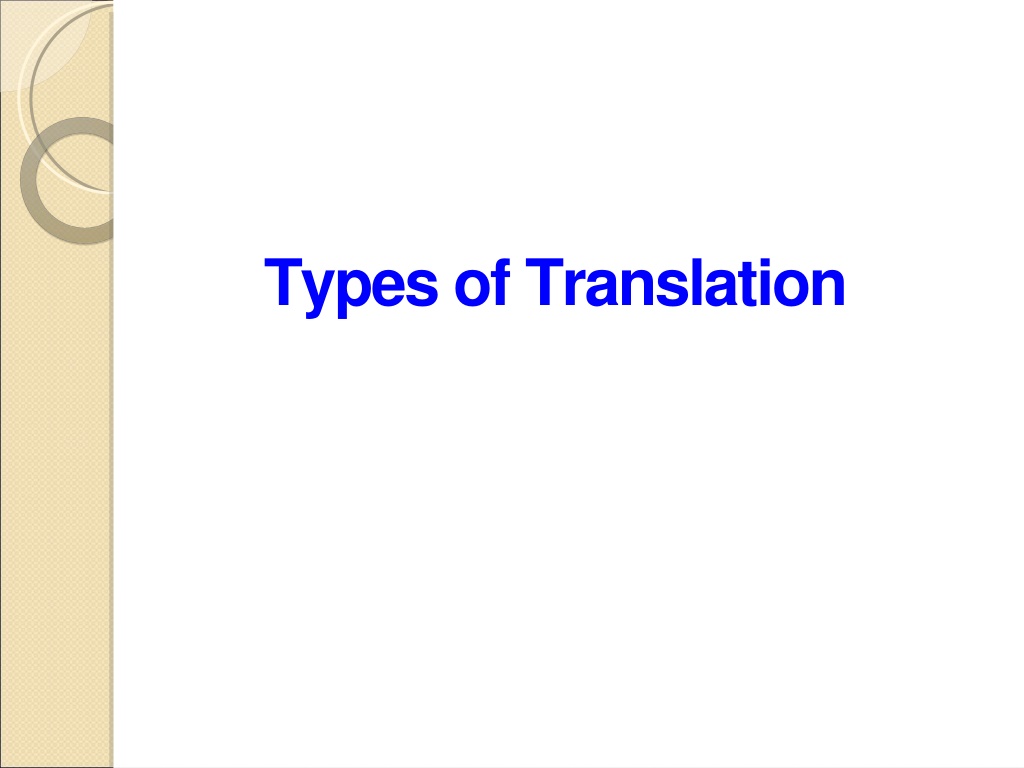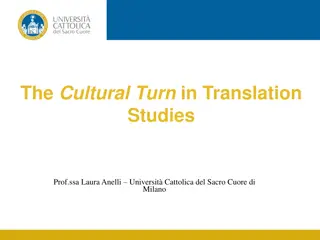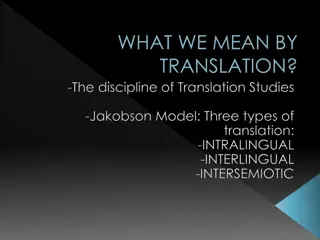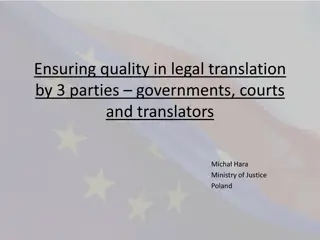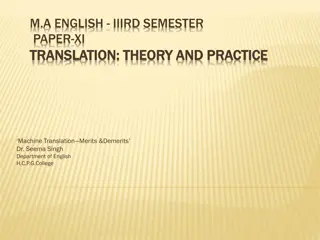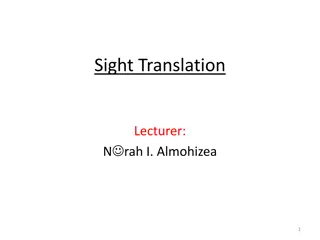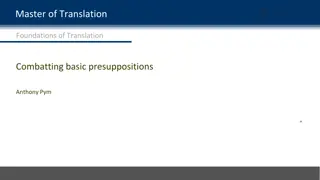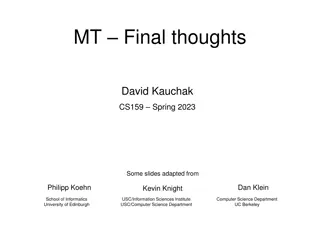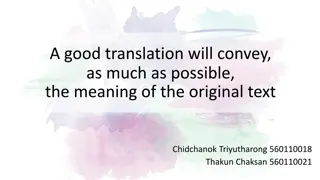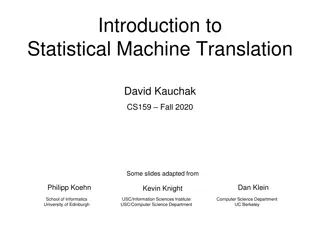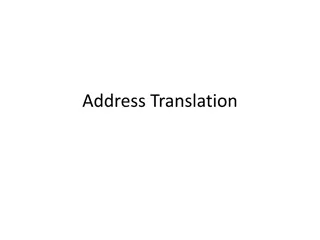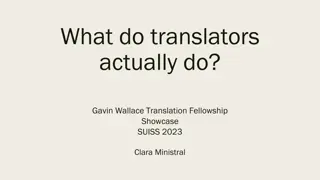Exploring Different Types of Translation
Discover various types of translation including oral, written, computer-assisted, machine translation, and back translation. Learn about the processes involved in each type and how they facilitate communication across different language cultures. Gain insights into the intricacies of translating spoken and written language, aided by human translators and computer programs. Delve into the nuances of machine translation and back translation to understand their role in conveying meaning accurately between languages.
Download Presentation

Please find below an Image/Link to download the presentation.
The content on the website is provided AS IS for your information and personal use only. It may not be sold, licensed, or shared on other websites without obtaining consent from the author. Download presentation by click this link. If you encounter any issues during the download, it is possible that the publisher has removed the file from their server.
E N D
Presentation Transcript
Definitions Oral sounding spoken language on a real time basis. It allows carrying communication between representatives of various language cultures. The structure conveys the content of oral speech through the vocabulary, grammar and peculiarities of intonation structures. As a rule, two main varieties of oral translation exist: simultaneous; consecutive Translation: is a translation of out of productive
Written Translation This is the rendering of a written text in one language in a comparable written text in another language.Written translation is accurate transmission of information, style and peculiarities of the language. Analyzing the meaning and structure of the original text, referring to the etymology and deep meaning of the words are the stages of the translation working process.
Definitions Computer-Assisted dellac retupmoc" - Aided Human "interactive translation," is a form of translation wherein a human translator creates a target text with the assistanceof acomputer program. It is the use of software to assist a human translator in the translation process.Thetranslation iscreated by a human, andcertain aspects ofthe processare facilitatedbysoftware. Translation aided translation , " Translation ,)TAC( " Machine- (MAHT)" osla and
Machine translation (MT) is a procedure whereby a computer program analyzes a source text and produces a target text without further human intervention. In reality, however, machine translation typically does involve human intervention, in the form of pre-editing andpost-editing. Machine translation (MT) is an automatic translation from one language to another. The benefit of machine translation is that it is possible to translate large swathes of text in a very short time.
Back Translation A back translation a translator is a procedure team whereby translators) interpret or re-translate a document that was previously translated into another language, original language. It helps a translation consultant determine if the original meaninghasbeen preserved in the target language. (or of back to the
6. Essentially literal translation The translators promote it as: an essentially literal translation that seeks as far as possible to capture the precise wording of the original text and the personal style of each writer. Its emphasis is on word-for-word correspondence, differences of grammar, syntax, and idiom between current literary English and the originallanguages. It seeks to be transparent to the original text, letting the reader see as directly as possible the structure and meaning of the original.
7. Free Translation A free translation is one which preserves the original but uses natural forms of the normal word order and naturally understood. meaning of the target language, including syntax, so that the translation can be It contains two types: 1. Bound Free Translation: This type of free translation is derived from the context in a direct way, though it may go out of it in some way or another, in the form of exaggeration, expressivity, effective, rhetorical, and very formal language. For example : 1. Proverbs: He got nothing at the end. ) ( / ( 2. Collocations: She was sad deep down You look quiet. My friend got to the top vey soon. ) ( / ( ) ) (
3. The Prophets Tradition: Swearing is a bad habit. ) ( 4. Poetry: East or west, home is best. ) Love me, love my dog . ( ) ( 5. Pompous , exaggerated expressions : Come down to earth. ) / ( 6. Popular religious expressions: She had a new baby. ) ( 7. Expressions from the Holy Quran: Are you lying to me ? ) ( The expressive, effective, and very formal Arabic. They derive that from the points used above. common point among these translations is their
All these free translations are derived in one way or another from the original. Although they may have gone far from the context, they have not gone to far from it, or outside. This means that his type of free translation is not loose, or without limitations, but is still bound to the linguistics context in some way. For these reasons, this method of free translation is sometimes acceptable. However, when translation is quite strange to the context, it is unacceptable. Still direct, literal translation of meaning is a better version for these statements, as suggested below : / . / . 7 8 . . 9 . . 10 . . . 6 . . . . . 1 2 3 4 5 . . . /
2. Loose free translation Some free translations do not relate directly to the original. They are concluded from it by the translator for different personal reasons. Here are some examples: 1. Thank you, Mr. Wilson. Next please. 2. Its half past nine. 3. Thank you, thank you ladies and gentlemen. 4. I am frightened. ) 5. Why are you making mouths? 6. No bacon with my breakfast, please. 7. Honesty is the best policy. 8. Books are very expensive today. 9.You should buy a lock for your car. ) 10. Have you classic records. ) / ) / ( ) / / ( ( ( ) ) ( ( ( ) ) ( ) / / ( ( 11
All these translations are conclusions reached at from the original. They are indirect, pragmatic translations, rendering the meaning intended by the speakers behind what they say. That is : Example (1): The speaker says thank you to a guest or a customer at the end of their meeting, as a sign of telling him/her to leave. So, instead of asking him/her directly to leave, he says thank you , which is understood as will you leave, the interview is over translated as . ) ( Example (2): The speaker her means to say that the time of a class, a meeting , etc., has expired, or the time of leaving, or doing something is due. Example (3): The speaker wanted to be so polite and respectful to people, so he uses thank you instead of quiet or silence, please to tell them to stop talking and listen. 12
Example (4): The speaker means to say that she/he cannot stay on his/her own because he/she is afraid of something. Therefore, he/she asks the listener to stay with him/her, however indirectly. Example (5): The speaker implies that making mouths is an expression of bad behavior. Therefore, the translation implication. expresses this ) ( Example (6): It indicates that the speaker is a Muslim because pig s meat (pork) is forbidden in Islam, but not in Christianity. That is why Arabic translation jumps to religion. Example (7): It is taken in an indirect comment on a dishonest act by the hearer. Hence the translation ( ) . 13
Example (8): It is a general comment on the expensiveness of books, but understood as an attempt to give one reason for the people s lack of interest in reading. Example (9): It is understood as a conclusion about the widespread car theft and vandalism these days. Example (10): It indicates the speaker s interest in classical music, which is an expression of his contempt of modern music. These are loose translations that have deserted their direct, home contexts completely. This free method of translation allows such looseness for the translator to translate the way he likes to understand, rather than the way he should understand according to certain contextual factors. It does not matter whether these translations are convincing and justified or not; what matters is that they do not translate the language and context we have on the page, but the personal conclusions of the translator. Therefor, they seem completely different from the original to the extent that they can be seen as unrelated to.
These translations are indirect, sometimes far interpretations of the original. This is not the job of the translator. His job is to transmit the text on the page directly and contextually into an equivalent TL text, which is closely, clearly and directly related to it. The interpretations and implications beyond it are left to the readers to conclude, exactly as they are left to them in English. It is not the responsibility of the translator to reveal and interpret what the source texts hides, or says indirectly. Therefore, the possible advisable Arabic versions for those English sentences can be as follows: . ( ) . . . . . / . . . . . 1 2 3 4 . ..... / . 5 . . . . . 10 . 6 7 8 9 / For all previous reasons, students are advised not to use this type of free translation.
8. Metaphorical Translation It involves the translation of SL metaphors into TL metaphors. Metaphors are not always creative, they are frequently used as decorative metaphors that are basically intended to decorate the text by injecting it with flowery language that is full with figures of speech. A quick look at advertisements and various forms of media, among their things, reveals how metaphorical the language used for general purposes has become. For example : a wilds goose chase , raise the roof , flog a dead horse , as dry as a bone , etc. By way of illustration, note the metaphorical English sentence below and its possible Arabic translations ( the first two renditions exemplify metaphorical translation, while the third exemplifies non-metaphorical translation): - Ahmed will be flogging a dead horse if he never tries to do a Ph.D. in linguistics. - . - . - .
9. Word-for-word translation A form of literal translation which seeks to match the individual words of the original as closely as possible to individual words of the target language. The translator seeks to translate an original word by the same target word as much as possible (this is technically called concordance). In addition, the order of words of the original language will be followed as closely as possible. No English translation, except for some interlinear translations, is a true word-for-word translation, but those who prefer this form of translation typically promote formally literal versions.
10. Precis Translation It is a translation method where the translator gives translations of the SL text he is dealing with. Such Tl summary translations usually provide the reader with only the main points of the SL text, thus ignoring many fine details that are contextually unimportant or, even, irrelevant. This translation practice is often common in different forms newspapers and News Agencies And TL summary of media like
